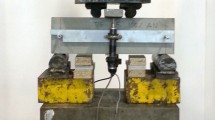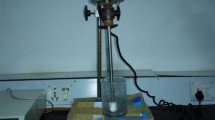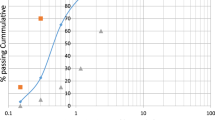Abstract
In this study, the bond strength between steel and concrete reinforced with multi-walled carbon nanotubes (CNTs) is analysed. To this end, pull-out tests were carried out for concretes with incorporation of 0.05–0.1% of different types of functionalized and unfunctionalized CNTs with distinct aspect ratios and dispersion techniques. The results showed that CNTs can improve both compressive strength and steel–concrete bond up to 21% and 14% respectively, as compared to plain concrete. The highest compressive strength was found in concrete with higher amounts of lower aspect ratio CNTs, while the best steel–concrete bond performance was attained for concrete with lower amounts of higher aspect ratio CNTs. CNTs were effective to retain the crack propagation, increasing the bonding stiffness and reducing the deformation of concrete consoles between steel ribs. CNTs of higher aspect ratio could better contribute with their microcrack bridging effect. Microscopic analysis confirmed the adequate dispersion and microcrack bridging provided by CNTs, delaying the macrocrack propagation within the aggregate–paste and steel–concrete interfacial transition zones.








Similar content being viewed by others
Abbreviations
- CNTs:
-
Carbon nanotubes
- CNTCOOH:
-
Carboxyl-functionalized nanotubes with –COOH groups and higher aspect ratio
- CNTOH:
-
Carboxyl-functionalized nanotubes with –OH groups and higher aspect ratio
- CNTPL:
-
Unfunctionalized carbon nanotubes with longer aspect ratio in the powder form
- CNTSL:
-
Unfunctionalized carbon nanotubes with longer aspect ratio in aqueous suspension
- CNTSS:
-
Unfunctionalized carbon nanotubes with shorter aspect ratio in aqueous suspension
References
Hawreen A, Bogas J, Guedes M (2018) Mechanical behaviour and transport properties of cementitious composites reinforced with carbon nanotubes. J Mater Civ Eng 30(10):04018257. https://doi.org/10.1061/(ASCE)MT.1943-5533.0002470
Carriço A, Bogas JA, Hawreen A, Guedes M (2018) Durability of multi-walled carbon nanotube reinforced concrete. Constr Build Mater 164:121–133. https://doi.org/10.1016/j.conbuildmat.2017.12.221
Hawreen A, Bogas J, Guedes M, Pereira MFC (2018) Dispersion and reinforcement efficiency of carbon nanotubes in cementitious composites. Mag Concr Res. https://doi.org/10.1680/jmacr.17.00562
Hawreen A, Bogas J, Guedes M, Pereira M (9/4/2017) Mechanical characterization of cement pastes reinforced with pristine and functionalized MWCNTs. In: Materiais, XVIII Congresso da Sociedade Portuguesa de Materiais, University of Aveiro, Aveiro
Iijima S (1991) Helical microtubules of graphitic carbon. Nature 354:56p. https://doi.org/10.1038/354056a0
Dresselhaus MS, Dresselhaus G, Eklund PC (1996) Science of fullerenes and carbon nanotubes. J Am Chem Soc 118:8987
Makar J, Margeson J, Luh J (21/8/2005) Carbon nanotube/cement composites-early results and potential applications. In: 3rd international conference on construction materials: performance, innovation and structural implications, Vancouver
Yu MF, Lourie O, Dyer MJ, Moloni K, Kelly TF, Ruoff RS (2000) Strength and breaking mechanism of multiwalled carbon nanotubes under tensile load. Science 287:637–640. https://doi.org/10.1126/science.287.5453.637
Peng B, Locascio M, Zapol P, Li S, Mielke SL, Schatz GC, Espinosa HD (2008) Measurements of near-ultimate strength for multiwalled carbon nanotubes and irradiation-induced crosslinking improvements. Nat Nanotechnol 3:626–631. https://doi.org/10.1038/nnano.2008.211
Cwirzen A, Habermehl-Cwirzen K, Penttala V (2008) Surface decoration of carbon nanotubes and mechanical properties of cement/carbon nanotube composites. Adv Cem Res 20:65–73. https://doi.org/10.1680/adcr.2008.20.2.65
Hawreen A, Bogas JA, Dias APS (2018) On the mechanical and shrinkage behavior of cement mortars reinforced with carbon nanotubes. Constr Build Mater 168:459–470. https://doi.org/10.1016/j.conbuildmat.2018.02.146
Musso S, Tulliani JM, Ferro G, Tagliaferro A (2009) Influence of carbon nanotubes structure on the mechanical behavior of cement composites. Compos Sci Technol 69:1985–1990. https://doi.org/10.1016/j.compscitech.2009.05.002
Guedes M, Hawreen A, Bogas J, Olhero S (4/62016) Experimental procedure for evaluation of CNT dispersion in high pH media characteristic of cementitious matrixes. In: 1º congress of tests and experimentation in civil engineering, Instituto Superior Técnico, Lisbon. https://doi.org/10.5281/zenodo.164637
Li GY, Wang PM, Zhao X (2005) Mechanical behavior and microstructure of cement composites incorporating surface-treated multi-walled carbon nanotubes. Carbon 43:1239–1245. https://doi.org/10.1016/j.carbon.2004.12.017
Sobolkina A, Mechtcherine V, Khavrus V, Maier D, Mende M, Ritschel M, Leonhardt A (2012) Dispersion of carbon nanotubes and its influence on the mechanical properties of the cement matrix. Cem Concr Compos 34:1104–1113. https://doi.org/10.1016/j.cemconcomp.2012.07.008
Collins F, Lambert J, Duan WH (2012) The influences of admixtures on the dispersion, workability, and strength of carbon nanotube-OPC paste mixtures. Cem Concr Compos 34:201–207. https://doi.org/10.1016/j.cemconcomp.2011.09.013
Zou B, Chen SJ, Korayem AH, Collins F, Wang CM, Duan WH (2015) Effect of ultrasonication energy on engineering properties of carbon nanotube reinforced cement pastes. Carbon 85:212–220. https://doi.org/10.1016/j.carbon.2014.12.094
Nochaiya T, Chaipanich A (2011) Behavior of multi-walled carbon nanotubes on the porosity and microstructure of cement-based materials. Appl Surf Sci 257:1941–1945. https://doi.org/10.1016/j.apsusc.2010.09.030
Kerienè J, Kligys M, Laukaitis A, Yakovlev G, Špokauskas A, Aleknevičius M (2013) The influence of multi-walled carbon nanotubes additive on properties of nonautoclaved and autoclaved aerated concretes. Constr Build Mater 49:527–535. https://doi.org/10.1016/j.conbuildmat.2013.08.044
Wille K, Loh K (2010) Nanoengineering ultra-high-performance concrete with multiwalled carbon nanotubes. Res Rec, Transp. https://doi.org/10.3141/2142-18
Gjorv OE, Monteiro PJM, Mehta PK (1990) Effect of condensed silica fume on the steel–concrete bond. ACI Mater J 87:573–580. https://www.concrete.org/publications/acimaterialsjournal.aspx%22
fib10 (2000) Bond of reinforcement in concrete. Bulletin 10, State-of-art-report. Lausanne: fib—CEB-FIP—Fédération internationale du béton
Walraven J, Stroband J (1995) Bond, tension stiffening and crack width control in lightweight concrete. In: International symposium on structural lightweight aggregate concrete, Sandefjord
Bogas J (2011) Characterization of structural concrete with light aggregates of expanded clay. Dissertation, Instituto Superior Técnico (in Portuguese)
Garcia-Taengua E, Martí-Vargas JR, Serna P (2016) Bond of reinforcing bars to steel fiber reinforced concrete. Constr Build Mater 105:275–284. https://doi.org/10.1016/j.conbuildmat.2015.12.044
Bogas J, Gomes M, Real S (2014) Bonding of steel reinforcement in structural expanded clay lightweight aggregate concrete: the influence of failure mechanism and concrete composition. Constr Build Mater 65:350–359. https://doi.org/10.1016/j.conbuildmat.2014.04.122
Bae BI, Choi HK, Choi CS (2016) Bond stress between conventional reinforcement and steel fibre reinforced reactive powder concrete. Constr Build Mater 112:825–835. https://doi.org/10.1016/j.conbuildmat.2016.02.118
Filho FM, El Debs MK, El Debs HC (2008) Bond-slip behavior of self-compacting concrete and vibrated concrete using pull-out and beam tests. Mater Struct 41:1073–1089. https://doi.org/10.1617/s11527-007-9307-0
Larrard F, Schaller I, Fuchs J (1993) Effect of the bar diameter on the bond strength of passive reinforcement in high-performance concrete. ACI Mater J 90:333–339. Retrieved from https://www.concrete.org/publications/internationalconcreteabstractsportal.aspx?m=details&ID=3888
Rostásy FS, Hartwich K (1988) Bond deformed reinforcing bar embedded in steel fibre reinforced concrete. Int J Cem Compos Lightweight Concr 10:151–158. https://doi.org/10.1016/0262-5075(88)90003-6
Dancygier AN, Katz A, Wexler U (2010) Bond between deformed reinforcement and normal and high-strength concrete with and without fibers. Mater Struct 43:839–856. https://doi.org/10.1617/s11527-009-9551-6
Lorrain M, Khelafi H (1988) On the resistance of high strength steel-concrete bond. Ann l’ITBTP 470:117–128 (in French). Retrieved from http://worldcat.org/issn/00202568
Neville A (1995) Properties of concrete. Pitman Publishing Comp. Ltd., New York
Almeida I (1990) High strength and durability concrete. Composition and characteristics. Dissertation, Laboratório Nacional de Engenharia Civil (in Portuguese)
Harajli M, Hamad B, Karam K (2002) Bond-slip response of reinforcing bars embedded in plain and fiber concrete. J Mater Civ Eng 14:503–511. Retrieved from https://www.concrete.org/publications/internationalconcreteabstractsportal/m/details/id/502
Bentur A, Mindess S (1990) Fibre reinforced cementitious composites. Elsevier Applied Science, London
Esfahani R, Rangan V (1998) Local bond strength of reinforcing bars in normal strength and high-strength concrete (HSC). ACI Struct J 95:96–106. Retrieved from https://www.concrete.org/publications/internationalconcreteabstractsportal/m/details/id/530
Orangun CO, Jirsa JO, Breen JE (1977) A reevaluation of test data on development length and splices. ACI Struct J 74:114–122. Retrieved from https://www.concrete.org/publications/internationalconcreteabstractsportal/m/details/id/530
Park R, Paulay T (1975) Reinforced concrete structures. Wiley, London
Banthia N, Sappakittipakorn M (2007) Toughness enhancement in steel fiber reinforced concrete through fiber hybridization. Cem Concr Res 37:1366–1372. https://doi.org/10.1016/j.cemconres.2007.05.005
Chen P, Chung DDL (1993) Concrete reinforced with up to 0.2 vol% short carbon fibres. Composites 24:33–52. https://doi.org/10.1016/0010-4361(93)90261-6
Elfeky M, Serag M, Yasien A, Elkady H (2016) Bond strength of nano silica concrete subjected to corrosive environments. ARPN-JEAS 11:13909–13924. Retrieved from http://www.arpnjournals.com/jeas/
Zacharda V, Němeček J, Štemberk P (2017) Micromechanical performance of interfacial transition zone in fiber-reinforced cement matrix. IOP Conf Ser Mater Sci Eng. https://doi.org/10.1088/1757-899x/246/1/012018
Park SH, Kim DJ, Ryu GS, Koh KT (2012) Tensile behavior of ultra high performance hybrid fiber reinforced concrete. Cem Concr Compos 34:172–184. https://doi.org/10.1016/j.cemconcomp.2011.09.009
EN197-1 (2011) Cement. Composition, specifications and conformity criteria for common cements
EN10002-1 (2001) Tensile testing of metallic materials. Method of test at ambient temperature
EN206-1 (2000) Concrete. Specification, performance, production and conformity
EN12390-2 (2009) Testing hardened concrete. Making and curing specimens for strength tests
EN12390-3 (2009) Testing hardened concrete. Compressive strength of test specimens
RILEM7.11.128 (1970) Essais portant sur ládhérance des armatures du béton. 2-Essais par traction. Bond test for reinforcing steel. Matériaux et constructions 3:175–178
Song X, Shang S, Chen D, Gu X (2017) Multi-walled carbon nanotube reinforced mortar-aggregate interfacial properties. Constr Build Mater 133:57–64. https://doi.org/10.1016/j.conbuildmat.2016.12.034
Li Y, Wang M, Zhao X (2007) Pressure-sensitive properties and microstructure of carbon nanotube reinforced cement composites. Cem Concr Compos 29:377–382. https://doi.org/10.1016/j.cemconcomp.2006.12.011
Abu Al-Rub RK, Ashour AI, Tyson BM (2012) On the aspect ratio effect of multi-walled carbon nanotube reinforcements on the mechanical properties of cementitious nanocomposites. Constr Build Mater 35:647–655. https://doi.org/10.1016/j.conbuildmat.2012.04.086
Chen SJ, Collins FG, Macleod AJN, Pan Z, Duan WH, Wang CM (2011) Carbon nanotube–cement composites: a retrospect. IES J Part A Civ Struct Eng 4:254–265. https://doi.org/10.1080/19373260.2011.615474
Haskett M, Oehlers DJ, Mohamed MS (2008) Local and global bond characteristics of steel reinforcing bars. Eng Struct 30:376–383. https://doi.org/10.1016/j.engstruct.2007.04.007
Lutz A, Gergely P (1967) Mechanisms of bond and slip of deformed bars in concrete. ACI J Proc 62-64:711–721
Campione G, Cucchiara C, Mendola L, Papia M (2005) Steel–concrete bond in lightweight fiber reinforced concrete under monotonic and cyclic actions. Eng Struct 27:881–890. https://doi.org/10.1016/j.engstruct.2005.01.010
Abrishami H, Mitchell D (1992) Simulation of uniform bond stress. ACI Mater J 89:161–168. https://www.concrete.org/publications/internationalconcreteabstractsportal/m/details/id/2237
Sonebi M, Davidson R, Cleland D (2011) Bond between reinforcement and concrete—influence of steel corrosion. In: 12th international conference on durability of buildings materials and components, Porto
Serag M, Yasien A, Elfeky M, Elkady H (2017) Effect of nano silica on concrete bond strength modes of failure. Int J Geom 12(29):73–80
ACI318-11 (2011) Building code requirements for structural concrete
CSA (1994) Design of concrete structures for buildings. CAN3-A23.3-94
NZS3101 (2006) New Zealand concrete structures standards
Eligehausen R, Popov EG, Bertero VV (1983) Local bond stress–slip relationships of deformed bars under generalized excitations, Berkeley
Cairns J, Plizzari GA (2004) Bond behaviour of conventional reinforcement in fibre reinforced concrete, Varenna
García-Taengua E, Arango S, Martí-Vargas JR, Serna P (2014) Flexural creep of steel fiber reinforced concrete in the cracked state. Constr Build Mater 65:321–329. https://doi.org/10.1016/j.conbuildmat.2014.04.139
Yazıcı S, Arel HS (2013) The effect of steel fiber on the bond between concrete and deformed steel bar in SFRCs. Constr Build Matter 40:299–305
Haddad RH, Al-Saleh RJ, Al-Akhras NM (2008) Effect of elevated temperature on bond between steel reinforcement and fiber reinforced concrete. Fire Saf J 5:334–343
Söylev TA (2011) The effect of fibers on the variation of bond between steel reinforcement and concrete with casting position. Constr Build Mater 25(4):1736–1746
Baran E, Akis T, Yesilmen S (2012) Pull-out behavior of prestressing strands in steel fiber reinforced concrete. Constr Build Mater 28(1):362–371
Yang Y, Walraven JC, den Uijl JA (2009) Combined effect of fibers and steel rebars in high performance concrete. HERON 54(2–3):205–224
EN1097-6 (2013) Tests for mechanical and physical properties of aggregates. Determination of particle density and water absorption
EN1097-3 (1998) Tests for mechanical and physical properties of aggregates. Determination of loose bulk density and voids
EN933-4 (2008) Tests for geometrical properties of aggregates. Determination of particle shape. Shape index
EN1097-2 (2010) Tests for mechanical and physical properties of aggregates. Methods for the determination of resistance to fragmentation
Acknowledgements
The authors wish to thank SECIL Company for supplying the materials used in the experiments. The first author also would like to thank Fundação Calouste Gulbenkian (Portugal) for the financial support through Scholarship No. 125745.
Funding
This study was funded by Fundação para a Ciência e a Tecnologia (FCT) CEris–ICIST/IST (Grant No. UID/ECI/04625/2013).
Author information
Authors and Affiliations
Corresponding author
Rights and permissions
About this article
Cite this article
Hawreen, A., Bogas, J.A. Influence of carbon nanotubes on steel–concrete bond strength. Mater Struct 51, 155 (2018). https://doi.org/10.1617/s11527-018-1279-8
Received:
Accepted:
Published:
DOI: https://doi.org/10.1617/s11527-018-1279-8




